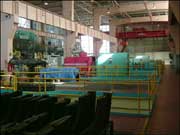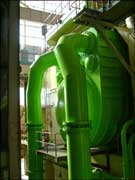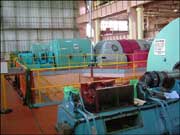10. Wairakei Turbines and Generators

The ways in which the geothermal fluid varies include
- the mass flow rate, pressure and volume of steam available
- the proportion of steam to hot water
- the ageing and use of the geothermal field
- improvements in bore technology
- environmental factors
The variety of these turbine - generator pairs is shown in the table below. Note there is presently a total of 10 generators with an 11th 'Binary Plant' under construction.
| Generator Number |
Location | Turbine | Generator |
| G1 |
Station A | Intermediate Pressure | 11.2 MW 3000 rpm 2pole |
| G2 |
Station A | taken out of service in 1984 | - |
| G3 |
Station A | Taken out of service in 1984 | - |
| G4 |
Station A | Intermediate Pressure | 11.2 MW 3000 rpm 2pole |
| G5 | Station A |
Removed to Ohaaki in 1984 | - |
| G6 | Station A |
Removed to Ohaaki 1984 | - |
| G7 |
Station A | Low Pressure | 11.2 MW 3000 rpm 2pole |
| G8 |
Station A | Low Pressure | 11.2 MW 3000 rpm 2pole |
| G9 |
Station A | Low Pressure | 11.2 MW 3000 rpm 2pole |
| G10 |
Station A | Low Pressure | 11.2 MW 3000 rpm 2pole |
| G11 |
Station B | Mixed Pressure | 30 MW 1500 rpm 4 pole |
| G12 |
Station B | Mixed Pressure | 30 MW 1500 rpm 4 pole |
| G13 |
Station B | Mixed Pressure | 30 MW 1500 rpm 4 pole |
| G14 | Stand Alone |
Intermediate Low Pressure | 4 MW 3000 rpm 2 pole Uses an asynchronous, induction generator |
| Binary Plant | Stand Alone | High Pressure | 14 MW Under construction |
The Types of Wairakei Turbines
1. Low Pressure Turbines
Wairakei Power Station has 4 Low Pressure steam turbines that all drive 2 pole generators at 3000 rpm.
In a Low Pressure turbine the steam enters in the centre and flows out towards the ends through five stages of blading, before being drawn into the condenser below.
The term 'Low Pressure' means that the steam is only at 1.1 atmosphere pressure (0.1 Bar gauge pressure). Although this is just above normal atmospheric pressure, the steam is able to drive the turbine because the condenser creates a vacuum on the output side, effectively sucking the steam through.
2. Intermediate Pressure turbines
Wairakei Power Station has 2 Intermediate Pressure steam turbines that both drive 2 pole generators at 3000 rpm.
The steam enters the turbine at 3.5 Bar of pressure and flows from the front towards the rear, pushing against 3 different stages of blading.
3. Mixed Pressure Turbines
Wairakei Power Station has 3 Mixed Pressure steam turbines
that drive 4 pole generators at 1500 rpm.
Mixed Pressure means that the same turbine is driven by one steam pressure
and then another.
The first is Intermediate Pressure steam at 3.5 Bar, which enters the turbine in the centre. The steam then pushes against 8 consecutive rows of blades, as it travels towards the front of the turbine. The pressure of the steam when it exhausts this inner casing is about 1.1 Bar, it is then turned around and flows back towards the generator between the inner and outer casings. Low pressure steam is added through another set of throttles. The steam goes through another 7 sets of blades before exhausting into the condenser.
4. High Pressure Turbines
The original High Pressure turbines have been removed from the Wairakei Power Station because the high pressure steam (12 bar or atmospheres pressure ) is no longer available from the geothermal field. These turbines are now used for generation at the Ohaaki Power Station.
5. The Binary Plant
The Binary Plant will use the heat energy in waste hot water to drive two 8 MW generators. However the binary plant needs about 2MW of power just to run its own pumps and fans so the overall generation is 14MW.
As the condensers are air cooled, the weather will have a big effect on output, with it being able to generate about 4MW more on a frosty night than a hot summer's day.
The Binary Plant uses hot water to heat the low boiling point (29 oC) liquid Iso-pentane The Iso-pentane gas is used to drive the turbine and generator.
This is done by
- Pumping the Iso-Pentane through a heat exchanger, at high pressure (11 Bar)
- Allowing the Iso-Pentane to boil
- Using the Iso-Pentane gas to drive a turbine
- Cooling and condensing the Iso-Pentane
- Repeating the process
The Binary plant has these advantages:
- An extra 14 MW of power is generated which is enough to supply about 10,000 homes.
- Cooling of the waste water makes is easier to remove dissolved contaminants such as Arsenic, Lithium and Silica
- It does not affect the supply of geothermal water used by others.
Condensers
Condensers rapidly condense the steam that is leaving the turbine. This causes a vacuum to form that effectively 'sucks ' the steam through the turbine, while it is being 'pushed' from the input side.
A Condenser doubles the power output of the turbines and generators. At Wairakei the Condensers are simple large open chambers into which river water is sprayed.
The cooling of the steam to form water releases a great deal of heat energy, mainly because it involves a change of state from gas to liquid. This why it takes 40kg of cool Waikato River water to condense each kg of steam.
The vacuum in a condenser is maintained using a Barometric Leg, which is a large column of water beneath the condenser through which the cooling water drains into the Waikato River. This allows the water to leave the condenser without it having to be pumped.
Non Condensable Gases
To create a good vacuum in the Condenser, some gases present in the steam and dissolved in river water have to be removed. These gases are called the non-condensable gases because they not totally soluble in the cooling water in the condensers.
About half of the non-condensable gases are from the steam. The rest is water vapour and gases that were dissolved in the cooling water. These gases are pumped from the top of the Condenser and ejected into the air above the Power Station.
Two gases in the geothermal steam, Carbon dioxide and Hydrogen
sulfide, are much more soluble and about half are absorbed into the cooling
water and discharged to the river. The remainder are also pumped from
the condenser by steam ejectors and discharged into the air.



